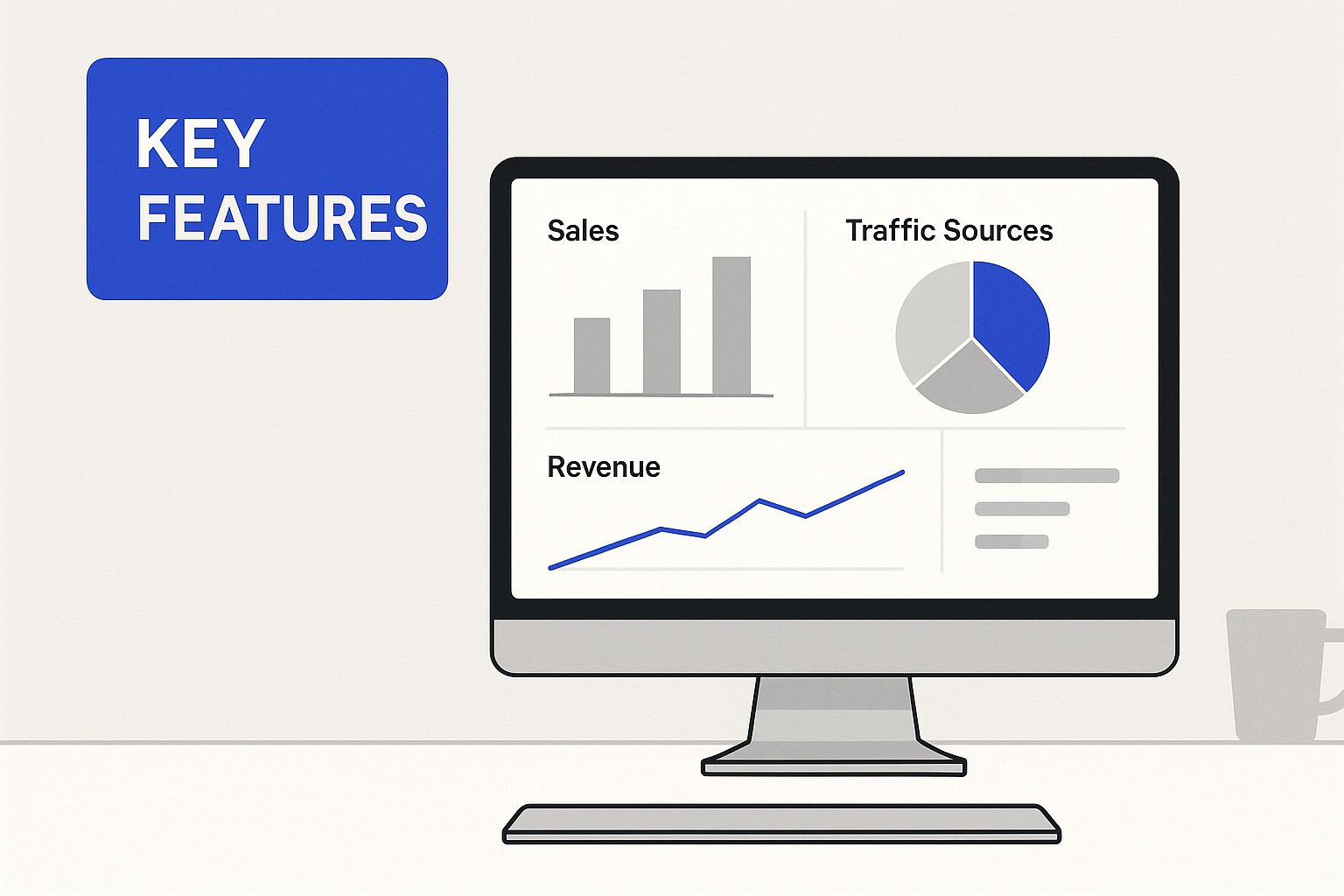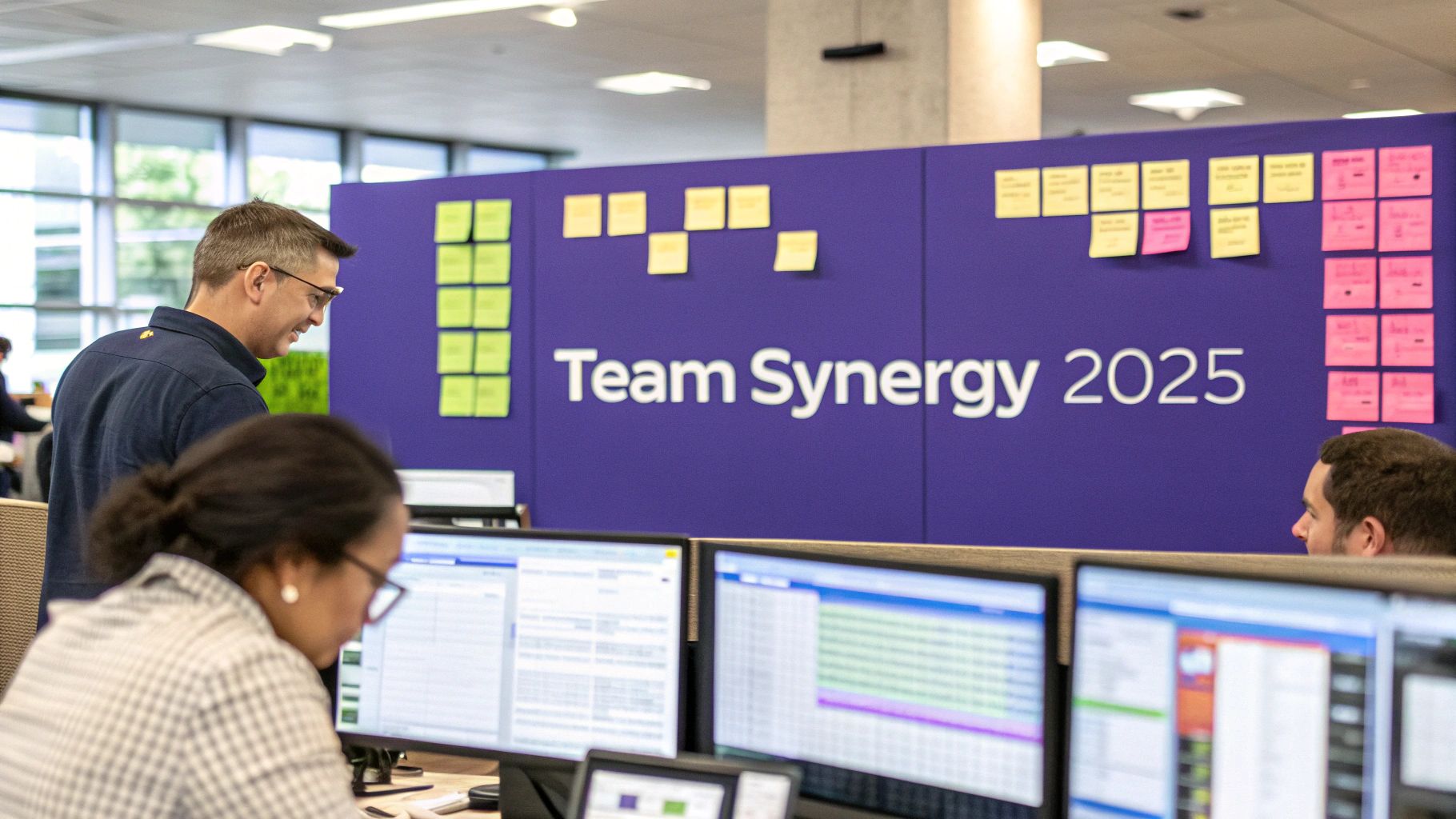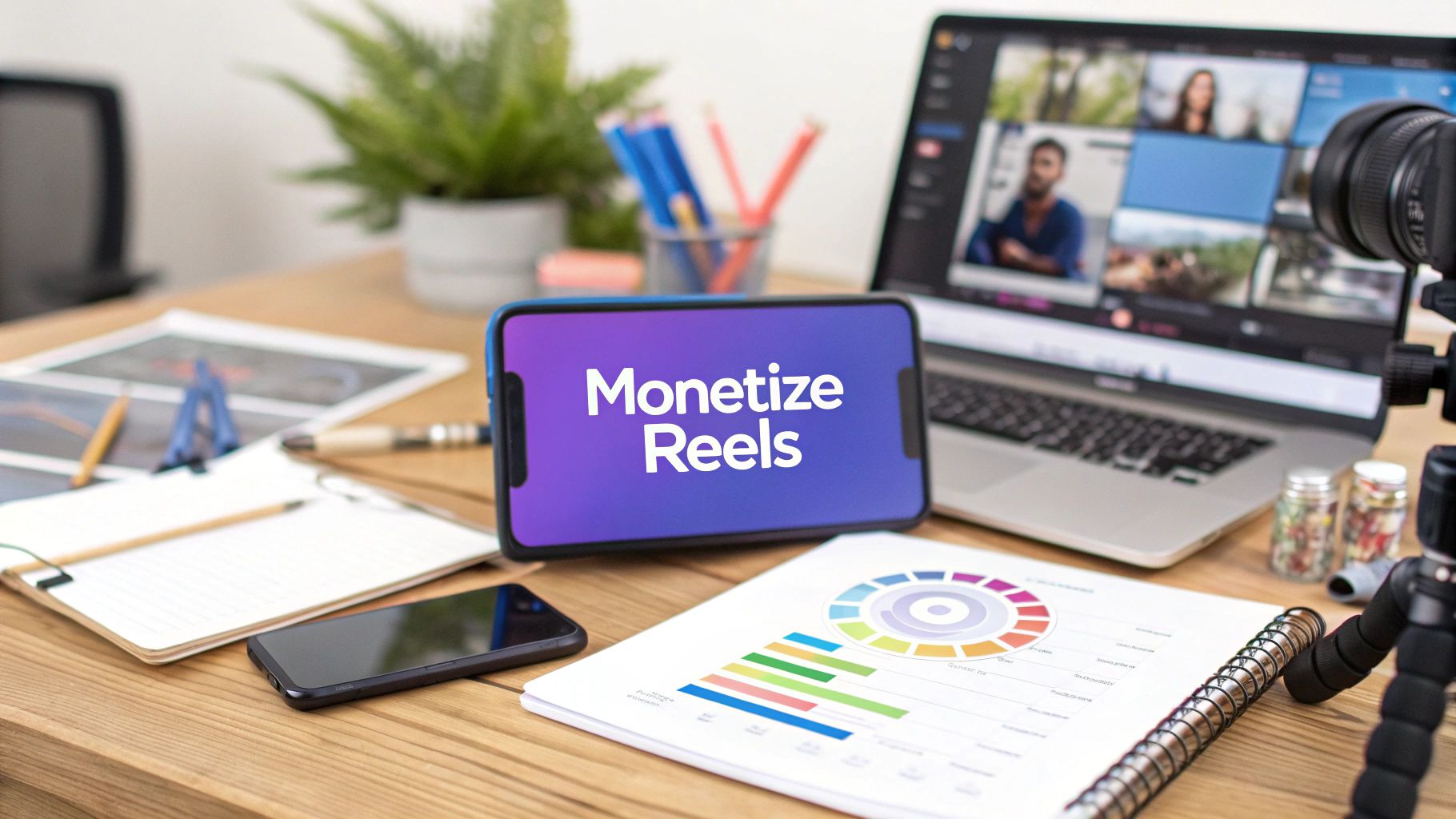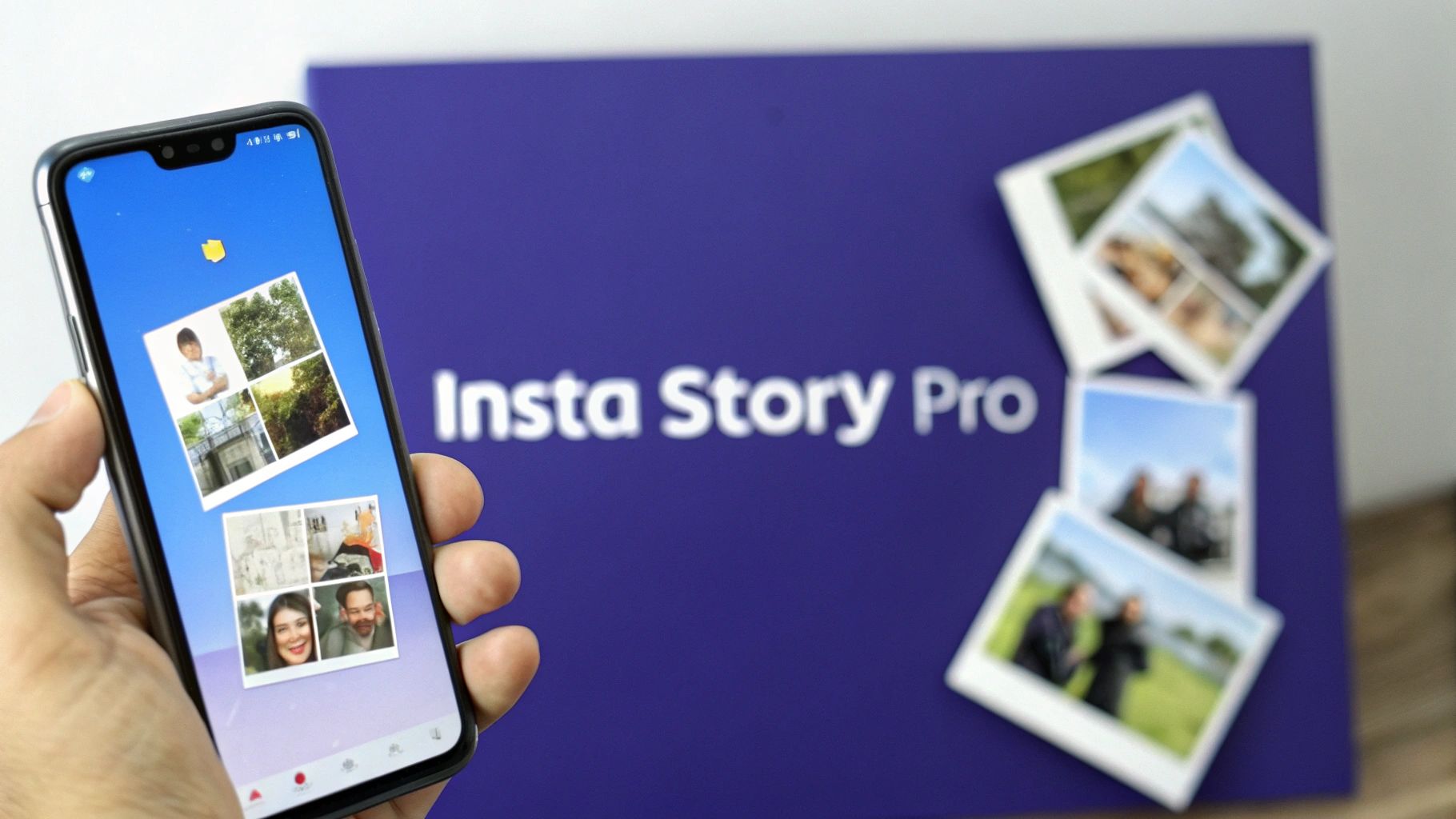Competitor tracking software is an automated platform that gathers and analyzes public data about your business rivals. Think of it as your team's game tape; it lets you study your competitors' entire playbook—from their pricing changes and marketing campaigns to their social media performance—all to find a strategic advantage.
This kind of intelligence is a complete game-changer for any business that’s serious about getting ahead and staying there.
Why Competitor Tracking Is Your Secret Weapon
Imagine trying to win a championship without ever watching your rivals' games. You'd be guessing at their strategies, totally unaware of their star players, and completely blind to their weaknesses. That's a losing strategy.
Operating a business without competitor tracking software is the modern equivalent of playing blind. You're leaving your success up to chance while your competition is meticulously studying your every move.
These powerful tools act as your digital scouts, working around the clock to gather publicly available information. Instead of your team spending countless hours manually checking websites, social media feeds, and news alerts, the software automates the entire process. It compiles a comprehensive dossier on your competition, turning scattered data points into a clear, actionable picture of the market.
What These Tools Actually Monitor
So, what kind of "game tape" are we talking about? This isn't about anything secretive or unethical. It’s all about systematically collecting and organizing information that your competitors are already sharing with the world.
Key areas of focus typically include:
- Website and SEO Changes: Tracking when a competitor updates their homepage, adds a new landing page, or starts ranking for a valuable keyword you've been targeting.
- Pricing and Product Updates: Receiving alerts when a rival launches a new product, adjusts their pricing tiers, or runs a limited-time promotion.
- Social Media and Content Strategy: Analyzing their most engaging posts, the frequency of their content, and the sentiment of their audience's comments.
- Advertising Campaigns: Seeing the ads they are running on platforms like Google and Facebook to understand their messaging and target audience.
It's no surprise the competitive intelligence (CI) market, which includes this type of software, was valued at $50.9 billion in 2024. It’s projected to more than double, hitting $122.8 billion by 2033. This massive growth shows just how essential these tools have become. If you want to dig deeper, you can explore the latest competitive intelligence trends and see how smaller businesses are increasingly getting in on the action.
The process is a continuous loop: you gather data, analyze it, and then act on it. This visualization shows it perfectly.
This diagram drives home a crucial point: tracking isn't a one-time task. It's a constant cycle of gathering, processing, and acting on information to maintain your edge.
By automating this loop, competitor tracking software ensures your strategic decisions are always based on current market realities, not outdated assumptions. It's what turns a reactive business into a market leader.
Decoding Features That Deliver a Winning Edge
Not all competitor tracking software is built the same. While many platforms promise a firehose of data, the real value comes from features that turn all that raw information into a clear strategic advantage. Think of it less like a spreadsheet of numbers and more like a set of specialized lenses, each one designed to bring a different part of the competitive landscape into sharp focus.
To pick the right tool, you have to look past the buzzwords and understand the core functions that actually move the needle. These are the features that don't just show you what your rivals are doing, but give you the insights needed to do it better.
This infographic breaks down the essential features that form the backbone of any effective competitor tracking platform.

As you can see, a powerful system pulls together monitoring across SEO, ads, content, and social media to paint a complete picture of your competitor's playbook. Let's break down what really matters.
Why You Need Real-Time Alerts and Notifications
Imagine your biggest competitor launches a surprise 48-hour flash sale. If you're tracking things by hand, you might not even know it happened until it's over. Real-time alerts are your early warning system, sending instant notifications about critical market moves straight to your email or a tool like Slack.
This is a non-negotiable feature for fast-paced industries like e-commerce or SaaS. For instance, an alert can be your heads-up when a competitor:
- Drastically drops the price on a key product.
- Puts out a press release announcing a new partnership.
- Gets hit with a sudden wave of negative reviews.
That kind of speed allows you to react fast—maybe by launching a counter-promotion or tweaking your marketing message—before a competitor’s move can seriously dent your market share. It’s the difference between responding to a threat and being completely blindsided by it.
SEO and Keyword Monitoring
Your competitor's SEO strategy is basically a public roadmap to their content priorities and who they're trying to reach. The right software lets you dissect this roadmap piece by piece, showing you exactly where they're strong and where you have an opening.
This goes way beyond just seeing what keywords they rank for. The best tools dig deeper.
A solid SEO tracking feature will show you your competitors' top-performing content, pinpoint "keyword gaps" (terms they rank for that you don't), and watch their backlink profile to see who’s giving them a vote of confidence. This is the intel you need to build a content strategy that systematically beats theirs.
For example, you might find a rival is ranking on page one for a high-intent keyword you hadn't even thought of. That insight is gold. You can create a better, more in-depth piece of content targeting that same term, effectively stealing their qualified traffic and sending it your way instead.
Social Media and Content Analysis
A competitor’s social media feed is a direct window into their brand voice, how they talk to their customers, and which campaigns are actually working. Trying to watch this all manually is a nightmare, but the right software automates it all, pulling in a ton of useful data.
Key functions to look for include:
- Engagement Tracking: Seeing what gets the most likes, shares, and comments to understand which content formats and topics hit the mark with their audience.
- Sentiment Analysis: Using AI to get a read on whether the chatter around their brand is positive, negative, or just neutral.
- Campaign Monitoring: Spotting their paid and organic social campaigns to decode their promotional strategies and messaging.
By studying this data, you learn from their wins and their mistakes—without having to spend your own money to find out what works. For a closer look, our guide on social media analytics and reporting offers a great framework for turning these numbers into a solid plan.
Advertising Intelligence
Why waste money guessing which ads will work when you can see what your competitors are already using to win customers? Ad monitoring features let you reverse-engineer their entire paid acquisition strategy. The software grabs their ads from platforms like Facebook, Instagram, and Google, showing you the exact creative, copy, and landing pages they’re using to drive conversions.
This is an absolute goldmine. You can see which value propositions they're pushing, what calls-to-action they rely on, and how long they run certain campaigns. This intel helps you create more powerful ads from day one, use your ad budget more wisely, and discover unique angles your competitors have completely missed.
The Strategic Gains of Watching Your Competition
Knowing the features of a competitor tracking tool is one thing, but seeing how they translate into actual business growth is where things get interesting. It’s all about flipping the script—moving from a defensive, catch-up posture to an offensive strategy that lets you call the shots in your market.
This isn’t just about dodging surprises from your rivals. It’s about methodically turning their every move into fuel for your own strategic fire. By keeping a close eye on the landscape, you can spot untapped market opportunities, see threats coming before they ever hit your bottom line, and massively speed up your own innovation cycle.
Find and Claim Untapped Market Opportunities
Let’s imagine a small but ambitious company called "Apex Solutions" that sells project management software. For years, they did what everyone else did: they targeted massive enterprise clients, just like their biggest competitors. But then, using a competitor tracking tool, they noticed something odd. Their top rival's social media engagement was blowing up, but only when they posted about features designed for freelancers.
The data told a clear story. While the competitor was pouring ad money into enterprise sales, their organic content was accidentally pulling in a completely different crowd. Apex Solutions saw the gap. They found a hungry, underserved market that their rival was cultivating by mistake but failing to serve.
That single insight was enough to pivot their entire marketing strategy.
By analyzing competitor data, Apex didn't just find a new audience; they found an audience their competitor was unknowingly cultivating but failing to serve. This is the essence of finding an untapped opportunity—identifying a need the market leader is missing.
Apex moved fast. They launched a new, lower-priced plan built specifically for freelancers. They tailored all their marketing to speak directly to the pain points of solo entrepreneurs—a conversation their bigger, slower competitors weren't even part of. In just six months, they captured a huge piece of this niche market, building a brand new revenue stream their rivals had completely ignored. To uncover similar goldmines, you have to know how to measure social media performance and spot these subtle shifts in audience behavior.
Anticipate and Neutralize Competitive Threats
Beyond just finding new wins, solid competitor tracking works like an early-warning system. Let’s stick with Apex Solutions. A few months later, their software flagged that another competitor was suddenly building tons of backlinks from influential tech blogs. At the same time, they started ranking for keywords around "AI-powered task automation."
There was no big product announcement, but this was the quiet prep work for one. Instead of waiting for the press release to drop, Apex’s product team got to work immediately, brainstorming how they could weave similar AI features into their own platform.
Because they saw it coming, they were able to fast-track their development and roll out a beta version of their own AI feature just weeks after their competitor's big, splashy launch. What should have been a major market disruption that sent them scrambling became a non-issue. They neutralized the threat by seeing it on the horizon and acting before it could damage their market share.
Accelerate Your Own Innovation
Finally, competitor tracking is an incredible shortcut to innovation. When you can watch the successes and failures of others, you get to learn powerful lessons without paying the tuition yourself. You can see which ad campaigns fall flat on their face, which new features get torn apart in reviews, and which pricing models make customers run for the hills.
Every piece of data helps you refine your own strategy, making sure you put your time and money into ideas with a much higher chance of success. This isn't just a clever tactic; it's quickly becoming standard practice. The global competitor analysis market was valued at $4.32 billion in 2021 and is projected to hit $6.6 billion by 2025, which shows just how critical this has become. You can read more research on the competitor analysis market growth to see how seriously businesses are taking this.
At the end of the day, this isn't about copying. It's about learning, adapting, and innovating faster and smarter than everyone else in your space.
Here’s how different industries get ahead using competitor tracking.
Competitor tracking software isn't a one-size-fits-all tool. Its real magic is in its flexibility—it delivers completely different, but equally valuable, insights depending on the industry you're in. The moves that help an e-commerce store dominate a holiday sale are a world away from how a SaaS company outsmarts a rival's big product launch.
Think of it like a master key. The key itself doesn't change, but it unlocks wildly different doors. Each door leads to a unique competitive advantage. Let's walk through how this "key" works in three distinct industries and see how you can apply the same thinking to your own market.
E-Commerce: Winning the War on Price and Promotions
The e-commerce world moves at lightning speed. Prices can shift by the hour, and a competitor's flash sale can snatch your customers in the blink of an eye. For an online shop, competitor tracking software is like a real-time market radar, absolutely essential for navigating the chaos of peak seasons like Black Friday.
Say you run an online electronics store. You can set up your software to:
- Monitor Dynamic Pricing: Get an instant alert the moment your top competitor slashes the price on a popular gaming headset by 15%. You can immediately decide to match their price or maybe launch a slick bundled offer to keep your edge.
- Track Promotional Campaigns: Instantly spot when a rival kicks off a "buy one, get one free" deal on smartphone accessories. This intel helps you decide whether to roll out a similar offer or double down on marketing the superior quality of your products.
- Analyze Shipping Offers: Get flagged when another store starts pushing free two-day shipping. That insight might be the nudge you need to tweak your own shipping policy and stop people from abandoning their carts.
Without this kind of automated oversight, you're just guessing. By the time you manually stumble upon a competitor's weekend promo, you've already lost two days of sales. This software transforms reactive panic into proactive, strategic moves.
SaaS: Dominating with Feature and Funnel Insights
For a Software-as-a-Service (SaaS) business, the game is less about daily price wars and more about the long-term marathon of product innovation and marketing. Here, competitor tracking becomes a strategic intelligence weapon, helping you figure out not just what your rivals are building, but how they're pulling in and converting new customers.
A B2B project management SaaS company, for instance, uses these tools to basically dissect their competitor's entire growth engine.
The goal isn't just to see a competitor's new feature announcement. It's to reverse-engineer the entire go-to-market strategy behind it—from the first blog post that teased the concept to the ad campaign that drove sign-ups.
This deeper dive means keeping tabs on a few key areas:
- Feature Launch Monitoring: The software can pick up on subtle changes to a competitor's website code or knowledge base, often signaling a new feature is in beta testing long before any public announcement. You get a heads-up.
- Content Funnel Dissection: You can map out a competitor's entire content machine, seeing which blog posts, whitepapers, and webinars are pulling in the most backlinks and social shares. This reveals exactly how they're educating the market and snagging leads.
- Review and Sentiment Analysis: By plugged-in monitoring of sites like G2 and Capterra, you get raw, unfiltered feedback on a rival's latest update. You can learn from their customers' complaints or praises to make your own product roadmap even stronger.
This kind of strategic vision helps a SaaS business see market shifts coming, pinpoint gaps in a competitor's product, and build a much more effective content marketing machine.
Local Services: Owning the Neighborhood
Even for a local business—think a digital marketing agency or a plumbing company—the battle for customers is won and lost online. Competitor tracking software helps these businesses climb to the top of their local search results and maintain a five-star reputation.
Take a local marketing agency. They aren't stressed about global pricing, but they are hyper-focused on their digital footprint right there in their city. They can use the software to:
- Monitor Online Reviews: Get an immediate heads-up when a competing agency gets a fresh 5-star review on Google, complete with the review text. This shows them what clients love about the competition, sparking ideas for improving their own services.
- Track Social Media Specials: See the moment a rival agency runs a "free social media audit" promo on Facebook or Instagram. This gives them the chance to counter with an even better offer.
- Analyze Local SEO Rankings: Keep a close watch on which keywords other local agencies are ranking for, like "SEO services in Austin," and tweak their own website and content to climb those same search rankings.
For local businesses, this software is the key to winning their own backyard. It makes sure they're always in the loop on competitors' local marketing tactics and customer feedback, letting them react fast to stay the top choice in town.
Choosing the Right Competitor Tracking Software
Now that you understand what these tools can do and why they matter, it’s time to pick the right one for your business. This isn't about finding the single "best" tool on the market. It's about finding the one that fits your goals, budget, and workflow like a glove.
Making the right choice here is critical. It stops you from paying for a bunch of flashy features you'll never touch. Even worse, it prevents you from investing in a tool that doesn't actually give you the specific insights you need to get ahead.
Think of it like hiring a new team member. You wouldn’t bring on a world-class accountant if your biggest problem was graphic design. In the same way, you need to match the software’s strengths to what your company actually needs to win. A little foresight now ensures your investment pays off with intelligence you can act on.
Define Your Primary Objective First
Before you even glance at a feature list, stop and answer one simple question: What is the number one problem I want this software to solve?
Getting crystal clear on this is the most important step. Without a defined goal, every feature will look shiny and important, and you'll end up stuck in analysis paralysis or making a bad call. Your main goal is your north star—it guides every other decision you make.
Here are a few common objectives to get you thinking:
- Gaining an SEO Advantage: Your top priority is to outrank competitors for valuable keywords. You need to decode their backlink strategy and find content gaps you can fill to climb the search rankings.
- Mastering Pricing Strategy: You’re in a fast-moving market like e-commerce and need real-time alerts on competitor price drops and promotions. Staying competitive is the name of the game.
- Achieving Social Media Dominance: You want to know exactly what makes your competitors' social content pop. The goal is to track their campaigns, spot what’s working, and find opportunities to capture your audience’s attention. If this is you, check out our deep dive into the best social media competitor analysis tools.
Once you nail down your primary goal, you can start building a shortlist of tools that actually specialize in that area.
Create a Practical Evaluation Checklist
With your objective set, you can now start evaluating software options with a practical checklist. This helps you look past the slick marketing copy and judge each tool on things that will actually affect your daily work. A structured approach means you're making a data-driven choice, not an emotional one.
When comparing platforms, focus on these four key pillars:
Scalability: Will this tool grow with you? A platform that’s great for tracking three competitors might become a clunky, expensive mess when you need to track ten. Look for flexible pricing and the ability to add more rivals or teammates without a headache.
Integration Capabilities: Your new software shouldn't be an island. It has to play nice with the tools you already use. Check for integrations with your CRM, project management software (like Asana or Trello), and especially communication platforms like Slack for getting those crucial real-time alerts.
Ease of Use: A powerful tool is worthless if your team finds it too confusing to use. Always look for a clean, intuitive dashboard and ask for a live demo to see it in action. A steep learning curve will kill adoption and waste your investment.
Pricing and ROI: Don't get tripped up by complicated pricing with hidden fees. You want transparent, straightforward costs that make sense for the value you're getting. Do a quick calculation on the potential return on investment—if the insights from the tool could help you win just a few more customers each month, does that justify the price?
This deliberate evaluation ensures you end up with a platform that becomes a core part of your strategy. For context, the global software market, which includes these powerful analytics tools, was valued at roughly $730.7 billion in 2024 and is projected to smash $1.4 trillion by 2030. You can see more on the growth of the global software market to grasp the sheer scale. Choosing wisely makes sure your slice of that investment delivers a real competitive edge.
Common Questions About Competitor Tracking Software
Jumping into the world of competitor tracking software always brings up a few practical questions. It's one thing to talk about features and strategy, but what about the day-to-day realities? Is this stuff even legal? What’s it going to cost me? How much time will this actually take? It's smart to get these answers before you commit.
Getting clear, straightforward answers is what gives you the confidence to move forward. This section cuts through the noise and tackles the most common concerns head-on, giving you the practical details you need to make sure your investment is a smart one.
Is Competitor Tracking Legal and Ethical?
This is usually the first question on everyone's mind, and the answer is a simple, confident yes. Ethical competitor tracking is a completely standard and legal business practice. There's a huge difference between competitive intelligence and corporate espionage, and these tools operate firmly on the right side of that line.
Competitor tracking software only gathers publicly available information. Think of it as having an incredibly dedicated assistant who automates what you could do manually—combing through websites, reading social media posts, checking public ad libraries, and noting prices on a competitor's website.
The key thing to remember is that this software only accesses data that your competitors have intentionally shared with the world. It’s not hacking, accessing private databases, or anything shady. It just organizes public information so you can analyze it strategically.
This practice isn't just legal; it’s a cornerstone of good market research. It’s how smart businesses stay in the loop on industry trends, customer preferences, and the competitive buzz, which ultimately leads to a healthier, more innovative market for everyone.
How Much Does Competitor Tracking Software Cost?
The price tag on these tools can swing wildly, from free versions with basic features to powerful enterprise platforms that run thousands of dollars a month. There's no single answer, but understanding how they're priced will help you find something that fits your budget.
Most platforms base their pricing on a few key factors:
- Number of Competitors Tracked: Most plans will limit how many rivals you can keep an eye on. A basic plan might let you track three to five, while premium tiers can handle dozens.
- Number of Users: The cost often goes up depending on how many people on your team need access.
- Feature Tiers: The really powerful stuff—like deep ad intelligence, sentiment analysis, or historical data—is usually reserved for the more expensive plans.
- Data Update Frequency: If you need real-time data and instant alerts, expect to pay more than you would for a plan that only refreshes data daily or weekly.
As a general rule, you can find entry-level plans starting around $50 to $150 per month, which is a great fit for small businesses. Mid-tier plans for growing teams often land in the $200 to $500 range, while large companies might invest $1,000 or more for all the bells and whistles.
How Often Should I Monitor Competitor Data?
Honestly, this all comes down to how fast your industry moves. There’s no magic one-size-fits-all schedule. The right rhythm is one that lets you react to important changes without getting totally swamped by notifications.
If you're a fast-moving e-commerce brand heading into the holiday season, real-time alerts are a must-have. A competitor dropping their prices or launching a flash sale requires an immediate response.
On the other hand, a B2B service provider will likely get more value from a weekly summary report. Their competitive landscape changes more slowly, so a weekly check-in is plenty to spot new blog strategies, case studies, or messaging tweaks without suffering from alert fatigue.
The best approach is to set up a layered alert system:
- Instant Alerts: For mission-critical events like big price changes or a new product launch.
- Daily Digests: For routine updates on things like social media engagement or new content.
- Weekly Reports: For a high-level look at SEO rankings and broader market share trends.
This kind of tiered system keeps you responsive when it counts, but lets you focus on the big picture the rest of the time.
Can Small Businesses Actually Benefit from This?
Absolutely. In fact, competitor tracking software can be a powerful equalizer for small businesses. It levels the playing field, giving you access to the kind of market intelligence that used to be reserved for huge corporations with massive research budgets.
For a small business, these tools aren't just a nice-to-have; they're a genuine strategic advantage. They let smaller, more nimble players outmaneuver their larger, often slower-moving competitors.
A small business can use this software to:
- Spot Niche Opportunities: Find underserved customer groups that the big guys are ignoring.
- React Quickly to Market Shifts: Change up your marketing or launch a new promotion in hours, not weeks.
- Learn from Bigger Budgets: See what’s working (and what’s not) for the industry leaders without spending a dime of your own on trial and error.
Affordable tools have made competitive analysis accessible to everyone. They empower small teams to make smarter, data-driven decisions that fuel growth and help them go toe-to-toe with anyone.
Ready to turn competitor insights into your strategic advantage? PostSyncer provides the in-depth analytics you need to understand your market and build a winning social media strategy. Start your free 7-day trial today and see what your competition is really up to.















